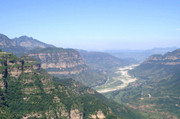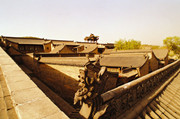Xuankong Temple
( chinadaily.com.cn )
Updated: 2011-09-28
Xuankong means hanging in the air for which the temple is famous for. It is located in the middle of the mountain and has existed for more than 1,500 years.
It is a must-go scenic spot in Hengshan Mountain and one of the nation’s key protected cultural relics, enjoying a high reputation both at home and abroad.
Facing Hengshan Mountain, the building enjoys a particularly exquisite structure. Looking up from the bottom of the valley, it is like a rainbow hanging over the precipice, while from across the valley it looks like a carving embedded on the wall.
Many ancient poets praised the spectacular scene. Li Bai, a great poet in the Tang Dynasty (AD618-907), once wrote how Zhuang Guan (spectacular) it was. Xu Xiake, a geographer and travel writer during the Ming Dynasty (AD1368-1644), acclaimed it as the world’s tremendous wonder.
The temple has 40 halls and pavilions. It has made full use of the mechanical principles by using rocks as supports. The beams and columns are seamlessly connected.
Tourists will find themselves in a fairyland when climbing up and down the hanging ladders, passing through the rock caves and walking on the roof ridges, the zigzag corridors and the trestle roads.
There are over 80 bronze, cast-iron, clay and stone statues of Buddha with high artistic value. It also has a small wooden sculpture of Guanyin which is regarded as a rare art treasure.
As China's oldest timber-framed building, the Xuankong Temple represents a classic ancient architectural art, combining the Three Chinese Religions: Confucianism, Buddhism and Taoism.




